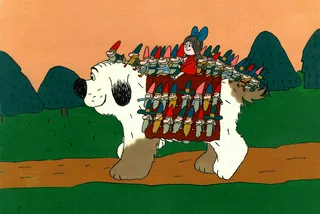Another popular Czech children’s character will be blasting into space. Hurvínek will be carried to the outer edge of the stratosphere on a Space X Falcon 9 rocket. Previously, a plush Krtek was on the next-to-last Space Shuttle mission in 2011.
A two-centimeter glass figurine of Hurvínek, half of the puppet team of Spejbl and Hurvínek, will set out into the stratosphere of our planet aboard the Planetum1 satellite, which is being launched in June. The launch of the 11th Czech or Czechoslovak satellite was announced last year, but the presence of its famous passenger was kept secret.
PARTNER ARTICLE
Miki Kirschner, the dramaturge of the Spejbl and Hurvínek Theater (Divadlo Spejbla a Hurvínka), initiated the collaboration with Planetárium Praha.
“Spejbl and Hurvínek are not only stars on the stage of our theater but two real asteroids are also named after them. … Now Hurvínek will have a chance to look at them from the deck of a satellite that ascends into the stratosphere of our planet,” Denisa Kirschnerová, director of the Spejbl and Hurvínek Theater, said.
Two asteroids were discovered on Oct. 27, 1997, by Lenka Šarounová from the observatory in Ondřejov, Central Bohemia, and have been named Spejbl and Hurvínek since June 24, 2002.

“Hurvínek has already undergone space training and at the beginning of the summer his greatest adventure awaits him,” Kirschnerová added.
The glass figure made by the Košler glass workshop had to undergo stress tests up to 16G to make sure it could hold up to the launch.
The Planetum1 satellite is a cubesat, a small satellite composed of cubes with standardized dimensions of 10 cubic centimeters. Planetum1 will be the basic version with one unit (1U).
The satellite will orbit approximately 550 km above the Earth's surface during its mission, or about 100 to 200 km higher than the International Space Station. It will orbit every 90 minutes at a speed of almost 28,000 kilometers per hour, fast enough to cover the distance between Prague and Brno in just 20 seconds.
The satellite will be used mainly for educational purposes. The control center in the Planetárium Praha, in Prague’s Stromovka park, will host school trips and hold workshops. Pupils will be able to communicate directly with the satellite, obtain flight data, or take orbital images. Spejbl, the other half of the puppet duo, will help them. The project is not only for children. University students will also have access to the satellite.
The characters’ names are also etched on a chip on NASA’s InSight spacecraft, which was sent to Mars in 2018. NASA has a program allowing people to add their names to tickets, and the two signed up. NASA is currently taking names for its Artemis lunar mission.
Three plays featuring the puppets, performed at the theater in Prague’s Dejvice neighborhood, have space themes: "Into the Stratosphere with Spejbl" from 1932, "Spejbl on Venus" from 1956, and "Hurvínek on a UFO" from 1997.
Spejbl made his first appearances in 1920. Hurvínek, his son, joined in 1926. they were designed by puppeteer Josef Skupa. The theater opened n Prague in 1930. Aside from theatrical performances, they can be seen on televised episodes in the “Večerníček” series.
The theater in Dejvice is currently preparing performances with subtitles in Ukrainian and is working on a special performance in the Ukrainian language. “We will be happy if we can bring Ukrainians who find themselves in a difficult life situation, in an unknown city and turbulent times at least a little distraction and optimism due to our characters,” artistic director David Janošek said.
In 2011, U.S. astronaut Andrew Feustel took a plush figure of the cartoon mole Krtek aboard the Space Shuttle Endeavour and on the International Space Station. Feustel’s wife, Indira, has Czech roots.
“Just as Krtek has been linked to the Czech Republic for so many decades, so has human space flight through the great pioneers Vladimír Remek, Jim Lovell, Gene Cernan, and John Blaha,” he said at the time, mentioning astronauts and cosmonauts with Czech roots. “Once Krtek reaches orbit, he will join the ranks of these space travelers.”












 Reading time: 3 minutes
Reading time: 3 minutes 





























